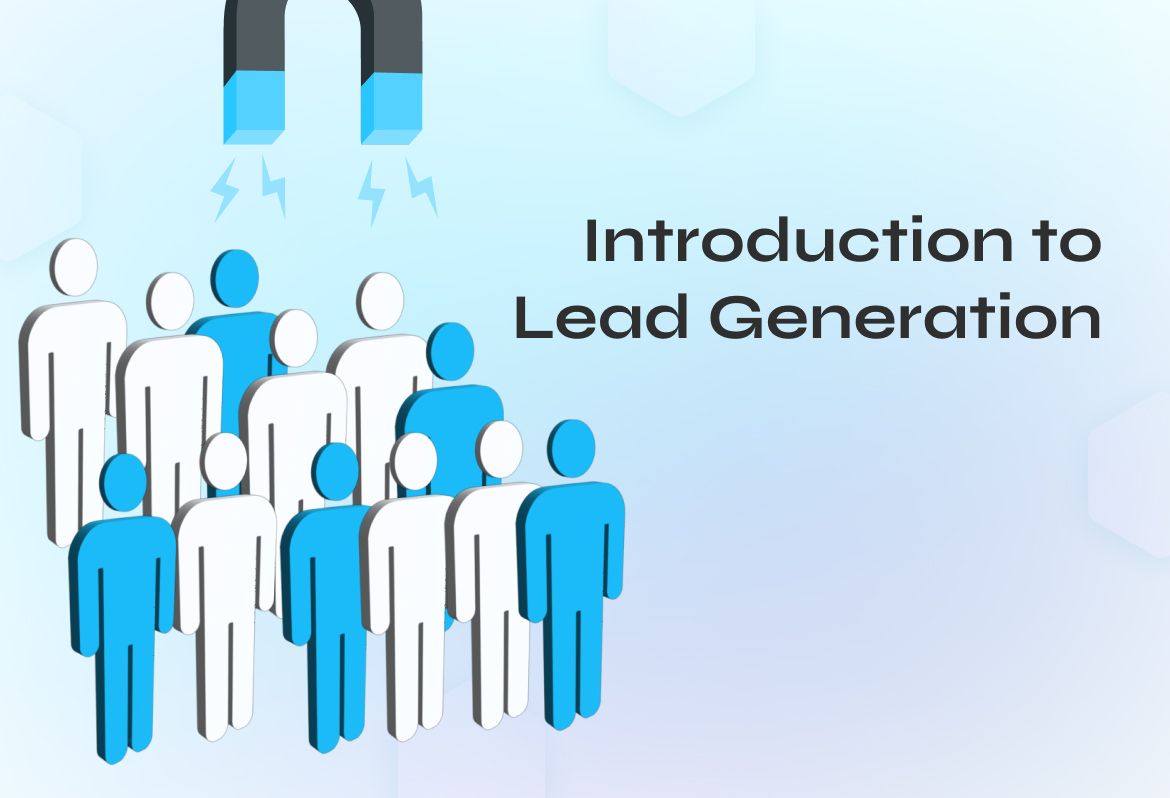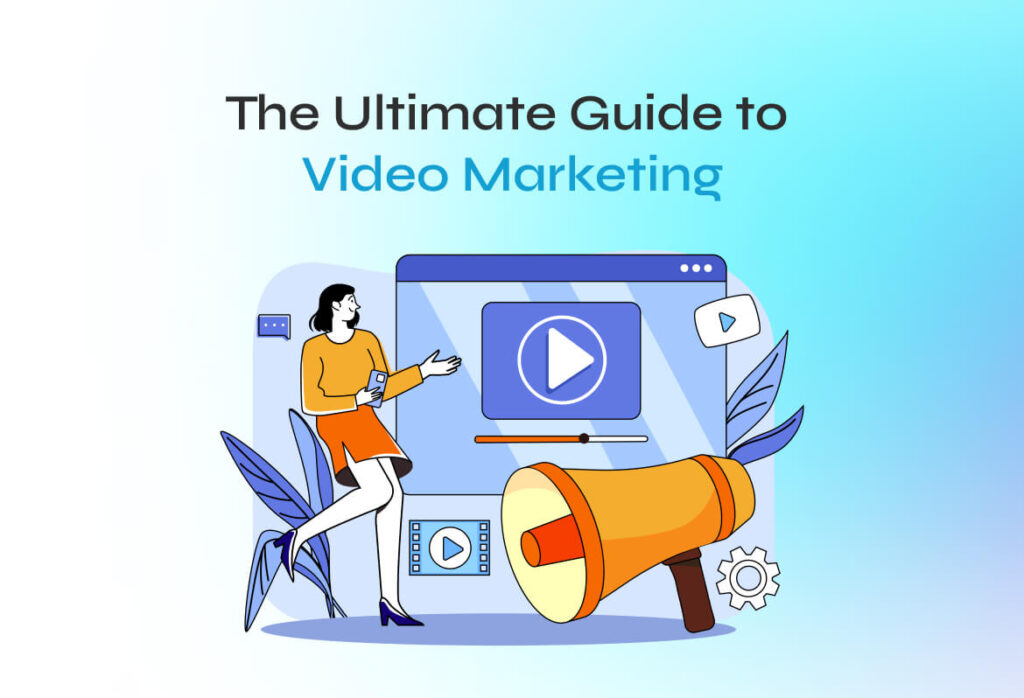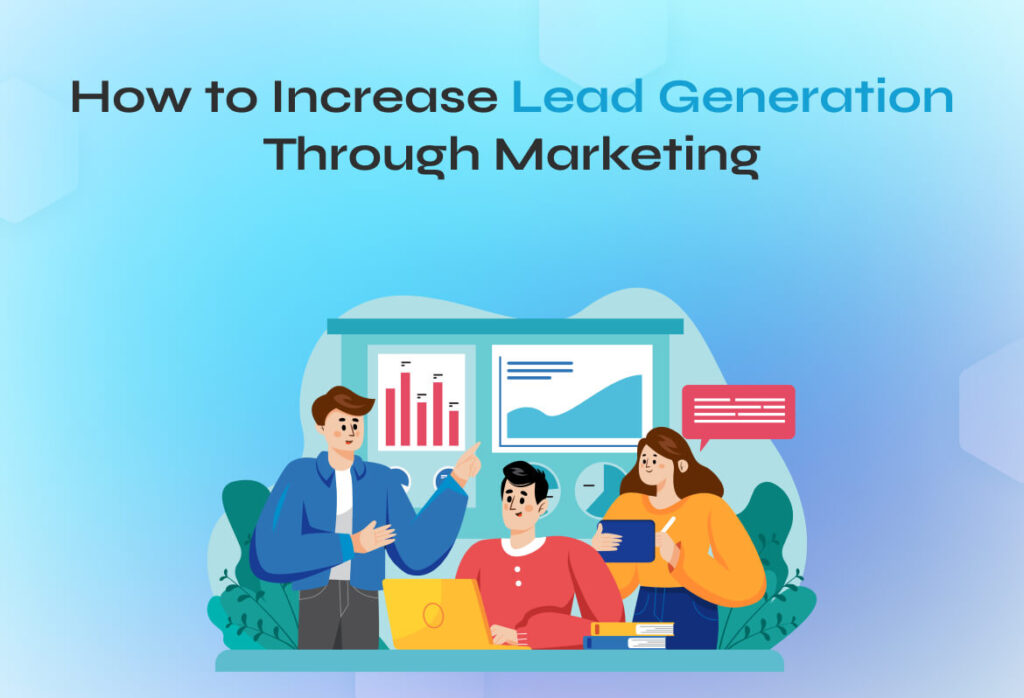Lead generation is a crucial aspect of any successful marketing strategy. It involves capturing the interest of potential consumers and nurturing them into qualified leads who are more likely to make a purchase.
In this comprehensive guide, we will explore the concept of lead generation, its importance for businesses, the lead generation process, modern techniques and strategies, as well as best practices for success.
Introduction to Lead Generation
In today’s digital age, consumers have access to an abundance of information, making it essential for businesses to attract and engage potential customers effectively.
Lead generation is the process of capturing the interest of individuals who have shown an inclination towards a product or service.
By connecting with these leads early on, businesses can build relationships and establish trust, increasing the likelihood of conversion when the leads are ready to make a purchase.
What is a Lead?
Before delving deeper into lead generation, let’s first define what a lead is. A lead is an individual who has demonstrated an interest in a company’s product or service.
Unlike cold calling, where businesses reach out to random individuals, leads are typically individuals who have initiated communication by providing their personal information in exchange for an offer, trial, or subscription.
For example, if you take an online survey about car care and receive an email from an auto company that created the survey, you have become a lead.
The Different Types of Leads
Not all leads are the same. Depending on their level of engagement and readiness to make a purchase, leads can be categorized into different types. Understanding these types is crucial for effective lead management and nurturing. Let’s explore some common types of leads:
- Hot Leads: These leads are ready to convert and have expressed a high level of interest in your offering. They are qualified, have purchasing authority, and may have already interacted with your sales team.
- Cold Leads: These leads are potential customers who are unfamiliar with your brand or offering. They have not yet shown any interest in what you’re selling and are generally more challenging to convert.
- Warm Leads: These leads fall between hot and cold leads. They are familiar with your brand and what you offer but have not directly contacted you. They may have engaged with your content, such as watching videos or reading blogs.
- Information Qualified Leads (IQLs): IQLs have shown interest in your company and have taken a specific action, such as signing up for your email newsletter or filling out a lead generation form. They are often looking for more information and are receptive to nurturing campaigns.
- Marketing Qualified Leads (MQLs): MQLs are further down the pipeline compared to IQLs. They actively seek a solution that meets their needs and want to determine if your offering fits the bill. These leads engage with content like whitepapers, videos, and attend corporate seminars.
- Sales Ready Leads (SRLs): Also known as “accepted leads,” SRLs are close to making a purchase. They have a clear budget, purchasing authority, and a defined timeframe for making a decision.
- Sales Qualified Leads (SQLs): SQLs are ready to buy and should be in direct communication with your sales team. These leads are considered hot, but they may still be evaluating your competitors.
Understanding the different types of leads allows businesses to tailor their approach and allocate resources accordingly.
The Importance of Lead Generation for Businesses
Lead generation is not just about generating sales; it serves multiple objectives for businesses. Here are some key reasons why lead generation is essential:
Building Brand Awareness:
Effective lead generation strategies help increase brand visibility and awareness among potential customers.
By capturing leads’ attention early on, businesses can establish themselves as industry leaders and build a positive brand reputation.
Collecting Customer Data:
Lead generation provides an opportunity to collect valuable customer data. By capturing leads’ contact information, businesses can create targeted marketing campaigns, personalize communication, and gain insights into their target audience’s preferences and needs.
Fostering Brand Loyalty:
Nurturing leads and maintaining ongoing communication can foster brand loyalty.
By providing valuable content and engaging with leads throughout their buying journey, businesses can build trust and loyalty, resulting in repeat purchases and customer advocacy.
The Lead Generation Process
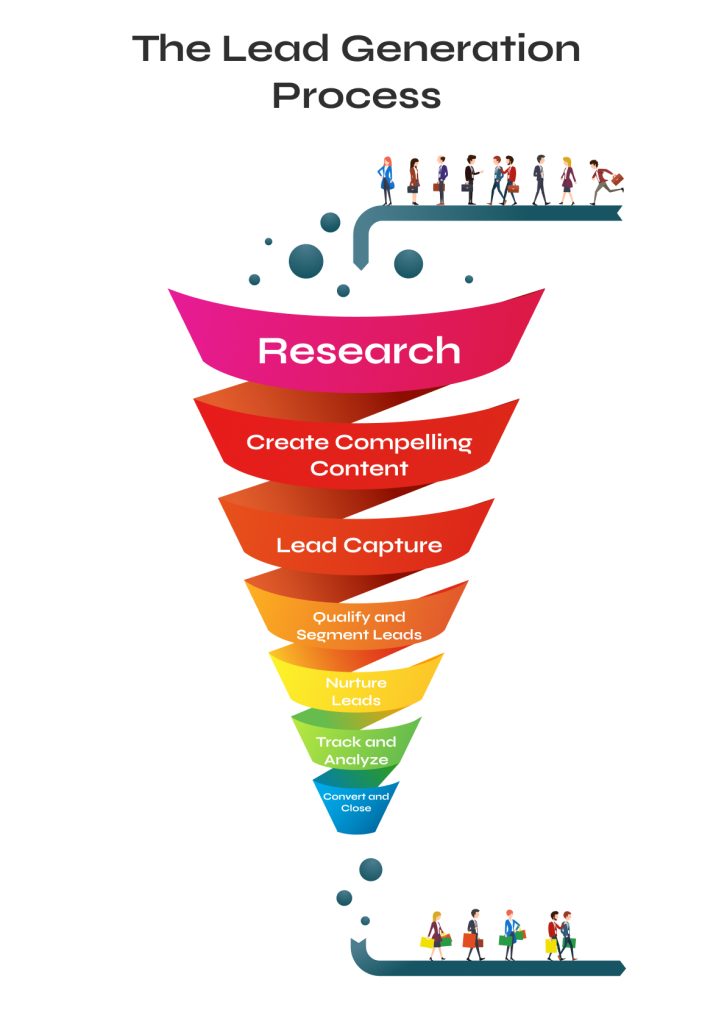
Now that we understand the importance of lead generation, let’s dive into the lead generation process. It typically involves the following steps:
- Research: Before embarking on lead generation efforts, it’s crucial to conduct thorough research. Identify your target audience, their demographics, preferences, pain points, and where they are most likely to engage with your brand.
- Create Compelling Content: Develop high-quality content that resonates with your target audience. This can include blog posts, videos, webinars, ebooks, and more. Tailor your content to address your audience’s pain points and provide valuable solutions.
- Lead Capture: Implement lead capture mechanisms such as landing pages, forms, and pop-ups to collect contact information from potential leads. Offer valuable incentives, such as free resources or discounts, to encourage visitors to provide their details.
- Qualify and Segment Leads: Once you’ve captured leads, qualify and segment them based on their level of interest and readiness to make a purchase. Use lead scoring techniques to assign scores based on lead engagement and actions taken.
- Nurture Leads: Implement lead nurturing strategies to build relationships with leads over time. Provide personalized content, follow-up emails, and targeted offers to keep leads engaged and move them further down the sales funnel.
- Track and Analyze: Utilize lead generation tools and analytics to track the effectiveness of your lead generation efforts. Monitor metrics such as conversion rates, lead quality, and engagement to identify areas for improvement.
- Convert and Close: When leads are ready to make a purchase, facilitate the conversion process by providing seamless and personalized experiences. Ensure your sales team is equipped with the necessary information to close deals effectively.
How To Start Generating Leads
Now that we’ve covered the lead generation process, let’s discuss how to get started with generating leads. Here are some key steps to follow:
Define Your Target Audience:
Clearly identify your target audience and understand their needs, preferences, and pain points. This will help you create content and offers that resonate with them.
Develop an Engaging Website:
Create a user-friendly website that showcases your brand, products, and services. Optimize it for search engines to attract organic traffic and implement lead capture mechanisms to convert visitors into leads.
Create Valuable Content:
Produce high-quality content that provides value to your target audience. This can include blog posts, videos, infographics, ebooks, and more. Focus on addressing your audience’s pain points and positioning yourself as an industry expert.
Implement Lead Capture Mechanisms:
Use effective lead capture strategies such as landing pages, forms, and pop-ups to collect contact information from potential leads.
Offer incentives, such as free resources, exclusive discounts, or access to gated content, to encourage visitors to provide their details.
Leverage Social Media:
Establish a strong presence on social media platforms that are popular among your target audience.
Share valuable content, engage with your followers, and use social media advertising to target potential leads.
Utilize Email Marketing:
Build an email list and leverage email marketing to nurture leads. Send personalized and relevant content, exclusive offers, and updates to keep leads engaged and move them closer to making a purchase.
Leverage SEO and Paid Advertising:
Optimize your website and content for search engines to improve visibility and attract organic traffic.
Additionally, consider using paid advertising platforms, such as Google Ads or social media ads, to reach a wider audience and generate leads.
Analyze and Optimize:
Continuously track and analyze the performance of your lead generation efforts. Monitor metrics such as website traffic, conversion rates, email open rates, and lead quality. Use the insights gained to optimize your strategies and make data-driven decisions.
Traditional vs. Modern Lead Generation Techniques
Lead generation techniques have evolved with advancements in technology and changes in consumer behavior.
While traditional methods like cold calling and direct mail can still be effective, modern techniques have proven to be more efficient and cost-effective.
Let’s compare traditional and modern lead generation techniques:
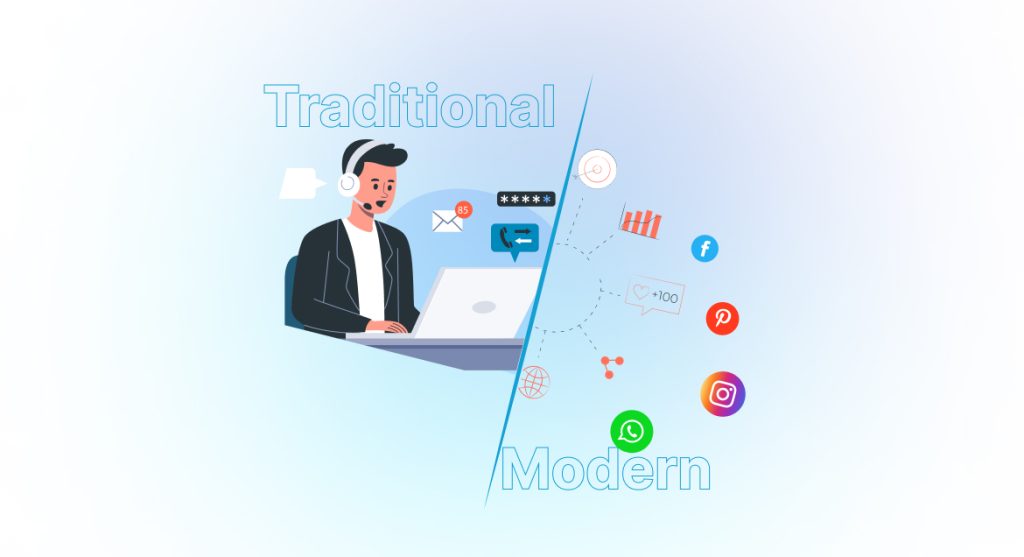
Traditional Lead Generation Techniques
- Cold Calling: This involves reaching out to potential leads via phone calls. While it can be effective, it often results in low conversion rates and can be seen as intrusive or annoying by prospects.
- Direct Mail: Sending physical mail, such as brochures or catalogs, to potential leads. This method can be costly and lacks the real-time tracking and personalization capabilities of digital techniques.
- Trade Shows and Events: Participating in industry trade shows and events to promote products and services and connect with potential leads. While effective for face-to-face interaction, trade shows can be expensive and time-consuming.
Modern Lead Generation Techniques
- Content Marketing: 76% of content marketers use content to generate leads. Creating and distributing valuable content to attract and engage potential leads. This can include blog posts, videos, podcasts, and social media content. Content marketing establishes thought leadership, builds brand awareness, and generates inbound leads.
- Social Media Marketing: Utilizing social media platforms to engage with potential leads, share valuable content, and run targeted advertising campaigns. Social media provides opportunities for direct interaction, brand exposure, and lead generation.
- Search Engine Optimization (SEO): Optimizing website content and structure to improve organic search rankings. SEO helps businesses attract organic traffic, increase visibility, and generate qualified leads.
- Email Marketing: Nurturing leads through targeted email campaigns. Email marketing allows businesses to deliver personalized content, offers, and updates to leads, keeping them engaged and moving them through the sales funnel.
- Paid Advertising: Utilizing pay-per-click (PPC) advertising platforms like Google Ads or social media ads to target specific audiences and generate leads. Paid advertising offers precise targeting options, real-time tracking, and measurable results.
- Lead Generation Tools and Software: Leveraging various lead generation tools and software to automate processes, track leads, and analyze data. These tools provide valuable insights into lead behavior, allowing businesses to optimize their strategies and increase conversion rates.
Modern lead generation techniques offer better targeting capabilities, cost-effectiveness, and the ability to track and measure results, making them more efficient and effective than traditional methods.
Lead Generation Strategies and Examples
Now that we understand the lead generation process and the importance of modern techniques, let’s explore some effective strategies and examples:
- Content Marketing Strategy: Develop a content marketing strategy that aligns with your target audience’s needs and preferences. Create valuable and engaging content, optimize it for search engines, and promote it through various channels like blog posts, videos, infographics, and social media.
- Social Media Advertising: Utilize social media platforms like Facebook, Instagram, and LinkedIn to run targeted advertising campaigns. Create compelling ad content, define specific audience segments, and monitor the results to optimize your campaigns.
- Webinars and Online Events: Host webinars or online events to educate and engage potential leads. Offer valuable insights, answer questions, and provide exclusive offers to webinar attendees. Collect contact information from participants to follow up and nurture leads.
- Interactive Quizzes and Surveys: Create interactive quizzes or surveys that provide personalized recommendations or insights to users. Ask for contact information in exchange for the results, allowing you to capture leads and provide tailored follow-up content.
- Referral Programs: Encourage your existing customers to refer your products or services to their networks. Offer incentives, such as discounts or rewards, for successful referrals. This strategy leverages the power of word-of-mouth marketing and extends your reach to new leads.
- Lead Magnets and Gated Content: Offer valuable resources, such as ebooks, whitepapers, templates, or exclusive access to webinars, in exchange for contact information. These lead magnets attract potential leads and provide them with valuable content while capturing their details for further nurturing.
- Influencer Partnerships: Collaborate with influencers or industry experts to promote your products or services. Partnering with influencers allows you to tap into their trusted networks, gain exposure to new audiences, and generate leads.
These are just a few examples of lead generation strategies that can be tailored to your business and target audience. It’s essential to continuously test, analyze, and optimize your strategies to maximize lead generation success.
Lead Generation Tools and Software
To streamline and enhance your lead generation efforts, numerous tools and software solutions are available. These tools offer various functionalities, such as lead capture, lead tracking, lead scoring, and automated email marketing. Here are some popular lead generation tools:
- HubSpot: HubSpot provides a comprehensive suite of tools for lead generation, including lead capture forms, CRM integration, and email marketing automation.
- Mailchimp: Mailchimp is a popular email marketing platform that offers lead capture forms, email automation, and analytics to track the performance of your email campaigns.
- Leadpages: Leadpages is a landing page builder that allows you to create high-converting landing pages with ease. It offers templates, A/B testing, and lead capture forms.
- SEMrush: SEMrush is an all-in-one marketing toolkit that provides keyword research, SEO analysis, and competitor analysis. It helps optimize your website for search engines and attract organic traffic.
- Google Analytics: Google Analytics is a powerful web analytics tool that provides insights into visitor behavior, traffic sources, and conversions. It helps you understand the effectiveness of your lead generation efforts.
- Sumo: Sumo offers a suite of lead capture tools, including pop-ups, scroll boxes, and welcome mats. These tools help you capture leads and grow your email list.
These are just a few examples of the many lead generation tools and software available. Explore different options, consider your specific requirements, and choose the tools that best align with your business goals and objectives.
Best Practices for Successful Lead Generation
To ensure successful lead generation, it’s essential to follow best practices. Here are some key tips to consider:
- Personalize Your Approach: Tailor your content and offer to address the specific needs and pain points of your target audience. Personalization helps create a connection and increases the likelihood of lead engagement and conversion.
- Establish Trust and Credibility: Build trust with potential leads by providing valuable and authoritative content. Position yourself as an industry expert and thought leader through informative blogs, case studies, and customer testimonials.
- Optimize Lead Capture Forms: Keep your lead capture forms concise and easy to fill out. Only ask for the information you absolutely need and clearly communicate the value of providing their details.
- Nurture Leads with Relevant Content: Develop a lead nurturing strategy that delivers relevant and timely content to your leads. Use email marketing, personalized landing pages, and targeted offers to keep them engaged throughout their buying journey.
- Measure and Track Results: Regularly monitor and analyze the performance of your lead generation efforts. Track metrics like website traffic, conversion rates, and lead quality to identify areas for improvement and optimize your strategies.
- Integrate Sales and Marketing Efforts: Foster collaboration between your sales and marketing teams to ensure alignment and maximize lead conversion. Regular communication and sharing of insights can result in more effective lead management and increased conversion rates.
By implementing these best practices, you can enhance your lead generation efforts and improve your chances of generating high-quality leads that are more likely to convert.
Measuring and Tracking Lead Generation Success
Measuring and tracking the success of your lead generation efforts is crucial for optimizing your strategies and achieving your business goals. Here are some key metrics to monitor:
- Conversion Rate: Measure the percentage of leads that convert into customers. This metric reflects the effectiveness of your lead nurturing and conversion strategies.
- Cost per Lead: Calculate the cost associated with generating each lead. This metric helps you evaluate the efficiency and cost-effectiveness of your lead generation campaigns.
- Lead Quality: Assess the quality of your leads based on their level of engagement, readiness to make a purchase, and alignment with your target audience. This metric helps you prioritize and allocate resources to leads with higher conversion potential.
- Website Traffic: Monitor the number of visitors to your website and track their behavior to understand the effectiveness of your lead generation efforts. Analyze metrics such as page views, time on site, and bounce rate.
- Email Engagement: Track metrics related to your email campaigns, such as open rates, click-through rates, and conversion rates. This data provides valuable insights into the effectiveness of your email marketing efforts.
- Social Media Engagement: Monitor engagement metrics on social media platforms, including likes, comments, shares, and click-through rates. This data helps you evaluate the impact of your social media lead generation strategies.
Regularly analyzing these metrics and making data-driven decisions allows you to refine your lead generation strategies, optimize your campaigns, and improve overall lead generation success.
Lead Nurturing and Conversion
Lead nurturing is a crucial part of the lead generation process. It involves building relationships with leads over time, providing them with valuable content, and guiding them through their buying journey. Here are some key strategies for effective lead nurturing:
- Segment Your Leads: Divide your leads into different segments based on their level of engagement, interests, and pain points. This allows you to deliver personalized and relevant content to each segment.
- Deliver Targeted Content: Develop a content strategy that caters to each segment’s specific needs and preferences. Provide valuable resources, educational content, case studies, and testimonials to nurture leads and build trust.
- Use Marketing Automation: Leverage marketing automation tools to deliver targeted emails, personalized landing pages, and automated follow-ups. Automation allows you to streamline your lead nurturing process and deliver consistent messaging.
- Implement Lead Scoring: Assign lead scores based on engagement levels, actions taken, and other relevant factors. Lead scoring helps you prioritize and focus on leads with a higher likelihood of conversion.
- Provide Timely and Relevant Offers: Tailor your offers to each stage of the buying journey. Provide incentives, discounts, or exclusive content that align with leads’ specific needs and interests.
- Maintain Ongoing Communication: Regularly engage with leads through email marketing, social media, and other channels. Keep them informed about new products, industry trends, and relevant updates to maintain their interest and loyalty.
By implementing effective lead nurturing strategies, you can guide leads through the conversion process, increase engagement, and improve your chances of converting leads into customers.
Conclusion: Getting Started with Lead Generation
Lead generation is a critical process for businesses looking to attract and convert potential customers.
By understanding the lead generation process, implementing modern techniques, and following best practices, businesses can generate high-quality leads and drive revenue growth.
Remember to personalize your approach, measure and track results, and continually optimize your strategies to maximize lead generation success.
Getting started with lead generation requires careful planning, research, and the right tools. Consider your target audience, develop compelling content, leverage lead generation software, and implement effective strategies to attract, nurture, and convert leads.
With a well-executed lead generation strategy, your business can thrive in today’s competitive marketplace.
Now that you have a comprehensive understanding of lead generation, start implementing these strategies and techniques to generate qualified leads and drive your business forward. Happy lead hunting!

